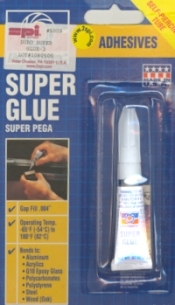PERMATEX Super Glue-3 Cyanoacrylate glue system, 2 g
| Availability | Contact for Availability |
|---|---|
| Item | 05009-AB |
Chemical name: Cyanoacrylate
Synonyms: 2-propenoic acid, 2-cyano-, ethyl ester; (ethyl cyanoacrylate)
CAS #: 7085-85-0
RTECS Number: UD3330000
2 g
This very popular cyanoacrylate-based system bonds in seconds; Holds up to 5000 lbs. Now we have not ever encountered a sample weighting 5000 lbs going into a SEM, but the real point is it is a highly reliable and strong adhesive, that also has excellent off-gassing properties. The adhesive itself dries to a clear, permanent bond. Smart EM lab managers are known to keep a few of the tubes because there is just no telling when they might come in handy around the laboratory!
Looking for a better adhesive for gluing together layers of silicon for TEM sample preparation? Then look no further. The Super Glue-3 cyanoacrylate is used world-wide for the preparation of samples for both Tripod™ Polishing and/or ion milling. And in the end, it is acetone soluble. Be sure to keep in mind that cured cyanoacrylates are generally thought to have a useful temperature range from -65°F (-54°C) to 180°F (82°C). This compares to a useful temperature upper limit for most epoxies of 200° F (93° C).
It is also perceived that a cyanoacrylate is not completely cured until the passing of twenty four hours. We do not recommend the use of this product on glass and one can expect bond failure when applied to glass to occur within a few days. If indeed it is used on glass, then it should be strictly for a temporary application and at the very maximum a one week life might be expected. However, if immersed in water or exposed to sterilization conditions, then the time to failure would be significantly less.
Special technical note: Make a mistake and you want to remove the Super Glue-3? Soak in either acetone or methylene chloride for twenty four hours. This might not actually dissolve away completely the cross-linked polymer, but it should soften it enough to make possible the removal of the glue from the sample.

